Modern Chinese anti-ship missiles of foreign origin
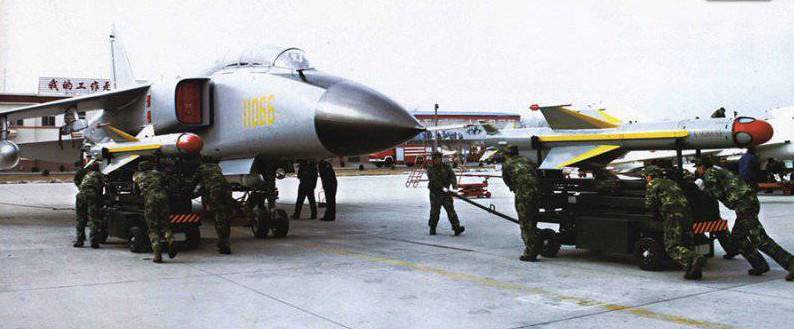
In the late 1970s, the PLA did not have any other cruise anti-ship missiles, except for those created on the basis of the Soviet P-15 anti-ship missiles. Chinese specialists were actively engaged in improving the basic design of the P-15, creating a number of modifications, and in some ways even surpassed the missiles of this family, adopted by the Soviet fleet. However, by that time, people who were at least a little familiar with the realities of operating naval rocket technology, it became obvious that bulky structures with subsonic flight speeds, refueling with toxic fuel and an aggressive oxidizer, had practically exhausted their potential.
I must say that in the USSR and in the West there were different views on anti-ship missiles, and this affected their technical appearance and method of application. The admirals of the Soviet Navy believed that anti-ship missiles were the "main caliber", and with their help the largest enemy ships should be destroyed at over-the-horizon distances. As a result, Soviet anti-ship missiles were very bulky and heavy, carrying a very powerful conventional warhead or nuclear warhead.
Soviet anti-ship and coastal-based anti-ship missiles, with the exception of the P-15 family, were mainly equipped with turbojet engines. Solid rockets have been developed for submarines and missile boats. At the same time, the P-70 Amethyst solid-fuel anti-ship missile with a starting weight of 2 kg could hit targets at a distance of up to 900 km, and the P-80 Malachite, weighing 120 kg, flew 5 km.
In the West, in the 1970s, relatively compact and inexpensive anti-ship missiles with solid fuel engines were mainly designed. The exception was the American AGM / RGM / UGM-84 Harpoon and RGM / UGM-109B TASM with turbojet engines. But at the same time, the American "Harpoon", put into service in 1977, with a launch weight of about 700 kg and 225 kg of the warhead, had a flight range of up to 140 km. For comparison: the French solid-propellant anti-ship missile Exocet AM / SM-39, put into service in 1979, had a weight of 165 kg, carried 50 kg of warheads and could hit targets at ranges up to 70 km.
The normalization of relations between Beijing and Washington and the rapprochement between China and the United States on the basis of anti-Sovietism in the early 1980s provided China with access to modern Western technologies, which made it possible to create its own analogues of the Exocet and Harpoon missiles. Since the early 1990s, Russia has been supplying the PRC with the Moskit, Club-S, and X-31 anti-ship missiles, which were used as part of the armament of Russian-built destroyers, submarines, and heavy multirole fighters. A detailed acquaintance with Russian missiles made it possible to design and put into production our own analogues.
RCC family YJ-8
During the years of the Cold War, the PLA Navy was mainly entrusted with the task of protecting the coast; China could not then compete with the fleet of the United States and its allies. In this regard, the military-political leadership of the PRC has relied on the "mosquito fleet" and submarines operating in the coastal zone. The Chinese admirals were very attentive to new types of weapons capable of giving an "asymmetric response" to a strong enemy and changing the nature of war at sea.
Quite quickly, Chinese intelligence obtained details of the use of P-15 anti-ship missiles in the Arab-Israeli wars. In 1967, due to the element of surprise, the Arab missile boats of the 183P Komar project type acted very successfully, and the Eilat destroyer with a displacement of 1 tons became the largest Israeli warship sunk. But in 710, the Arabs could not achieve success and, thanks to the competent actions of the Israeli sailors, who used new tactics and means of jamming, they suffered significant losses.
Although in the PRC until the beginning of the 15st century, new modifications of coastal and air-based anti-ship missiles were created on the basis of the P-1970, it became clear to experts already in the XNUMXs that small and medium-sized warships needed compact missiles with solid-state control systems. electronics.
In addition, the use of a liquid-propellant jet engine operating on toxic and explosive components on rather bulky P-15 anti-ship missiles potentially threatened with serious troubles and reduced the combat survivability of the carrier. For short-range anti-ship missiles, the use of a solid-fuel jet engine was optimal, and for medium and long range, the use of a miniature turbojet engine.
However, the weakness of the Chinese radio-electronic industry did not allow the creation of compact and sufficiently reliable homing heads, and the lack of effective solid fuel formulations made it impossible to achieve the required firing range.
Chinese designers tried to get around these obstacles with the help of a fairly efficient intelligence service, which made great efforts, extracting various technical innovations around the world. But, even with a working sample on hand, it was often not possible to reproduce it. Progress in the creation of a new generation of anti-ship missiles was achieved due to the convergence of the positions of the PRC and the "democratic Western countries" led by the United States, who decided to be friends against the Soviet Union.
As a result, for a short period of time, which ended after the suppression of speeches in Tiananmen Square, the Chinese got the opportunity to access some Western weapons and technologies. The result of cooperation with the West was the appearance in the 1980-1990s in the PLA Air Force and Navy of a model range of missiles that were similar in appearance and characteristics to French and American models.
A real breakthrough was the adoption and mass production of the YJ-8 solid-propellant anti-ship missiles (export designation C-801). This missile, in its appearance, was strikingly different from the previous, more like aircraft, Chinese anti-ship missiles: both in terms of weight and size and combat characteristics, the YJ-8 strongly resembled the French Exocet anti-ship missiles, put into service 10 years earlier.
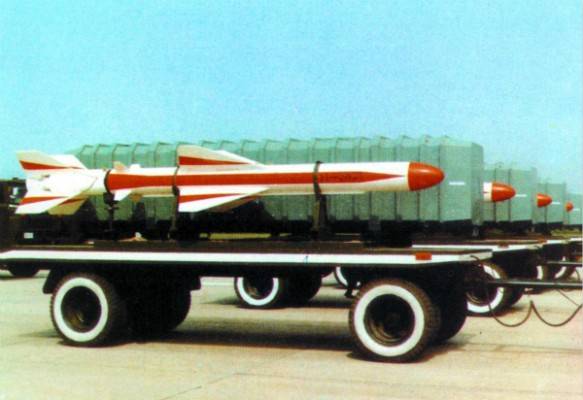
CRP YJ-8
The Chinese rocket is made according to the normal aerodynamic configuration with a folding cruciform triangular wing of small elongation (in the middle part) and control planes (located at the rear of the rocket). The hull of the YJ-8 anti-ship missile has a cylindrical shape with an ogive nose.
The launch weight of the rocket, equipped with an additional solid fuel booster, was 815 kg. The mass of the armor-piercing high-explosive warhead is 165 kg. Length - 5,814 m. Body diameter - 0,36 m. Wingspan - 1,18 m. Flight speed - about 300 m / s. The flight altitude on the marching section is 50 m. In the attack: 5–7 m. The launch range of the YJ-8 from a warship exceeded 40 km. On the march, an inertial control system is used, and an active radar guidance head is activated in the final section of the flight.
Since 1987, the YJ-8 has been introduced into the armament of the modernized Chinese frigates, pr. 053H2.
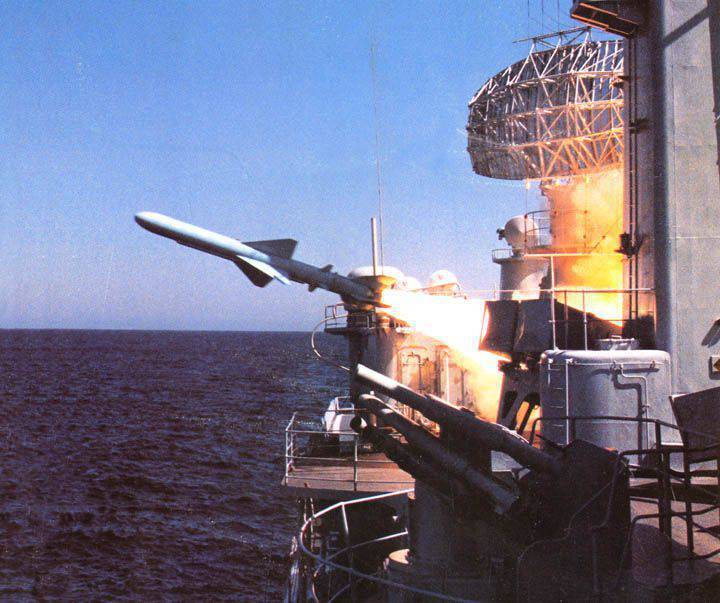
Aviation the version included in the arsenal of JH-7 aircraft was designated YJ-8K (YJ-81).
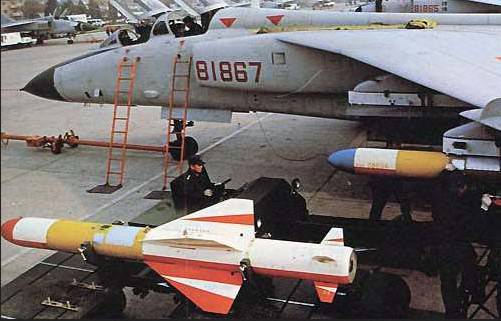
On this modification, which weighed 610 kg, there was no additional upper stage that was not needed for air launch. The firing range of the YJ-8K when launched from a height of 8 m reached 500 km.
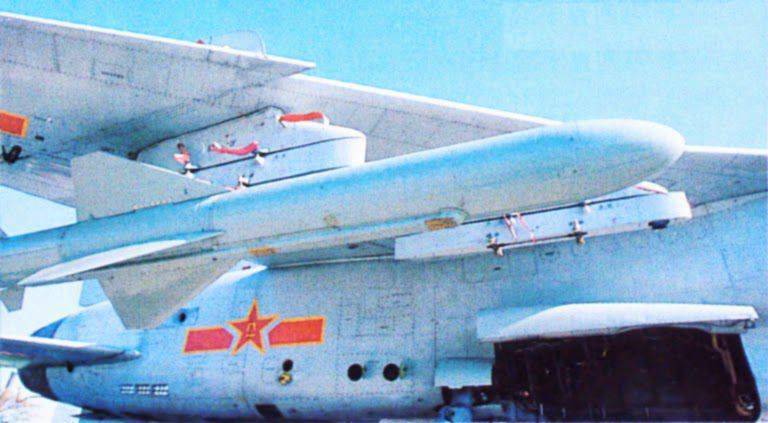
Anti-ship missiles YJ-81 under the wing of a JH-7 bomber
A few years after the YJ-8 anti-ship missiles, placed in above-deck launch containers, entered service, the YJ-8Q missile was tested and adopted, which could be launched from submerged submarine torpedo tubes.
In addition to the modification with an active radar seeker, on the basis of the YJ-8, variants with a thermal, semi-active radar or television guidance system were created. The aviation version of the missile with a combined television and infrared seeker, suitable for hitting both sea and land targets, is known as the KD-88.
By the mid-1990s, solid-propellant anti-ship missiles seriously increased the combat capabilities of the Chinese fleet and naval aviation. However, a solid-fuel jet engine, with all its many advantages, is not capable of providing a long flight range. Therefore, in the PRC, the YJ-82 (C802) anti-ship missiles with a turbojet engine were created. In terms of its characteristics, this Chinese missile is in many ways similar to the American RGM-84 Harpoon, but the Chinese anti-ship missile with a turbojet engine appeared 17 years later.
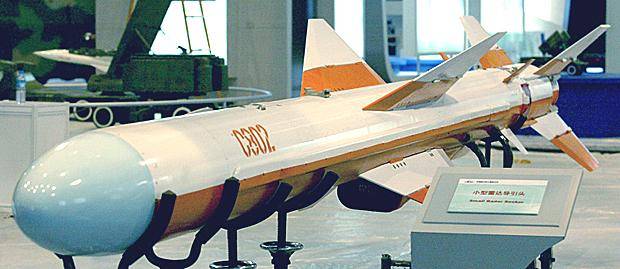
Layout of the export anti-ship missiles S802
The air intake is located on the bottom surface of the housing. The missile is equipped with an active monopulse radar seeker operating in the 10-20 GHz range, and equipment for receiving correction commands from the carrier, which is used in the initial section of the trajectory until the target is captured by the homing head. The developer offers export options, additionally equipped with a satellite navigation subsystem.
The launch of the YJ-82 from ship and ground launchers occurs with the help of a detachable solid-propellant launch booster. The launch weight of the rocket is 715 kg. YJ-82 launch range increased to 120 km. Flight speed on the cruising section - up to 320 m / s. The flight altitude on the cruising section of the trajectory is 20–30 m; in the final section of the trajectory, the rocket descends to a height of 5–7 meters and performs an anti-aircraft maneuver. Armor-piercing high-explosive warhead weighing 165 kg, which is detonated with a delay, is capable of inflicting heavy damage on a destroyer-class ship.
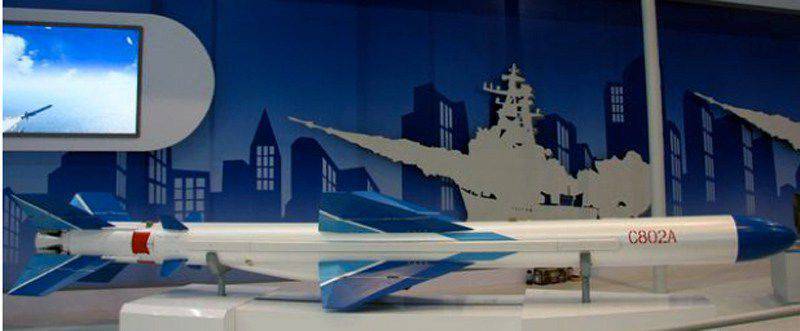
The YJ-82A aviation missile has a range of up to 180 km. Modification CM802AKG is designed to destroy ground targets, firing range - up to 200 km.
In 1999, the official Chinese media announced the adoption of the YJ-83 anti-ship missiles. This missile has a launch range of up to 180 km, for the aviation version of the YJ-83K - up to 250 km. The weight of the missile warhead is 185 kg.
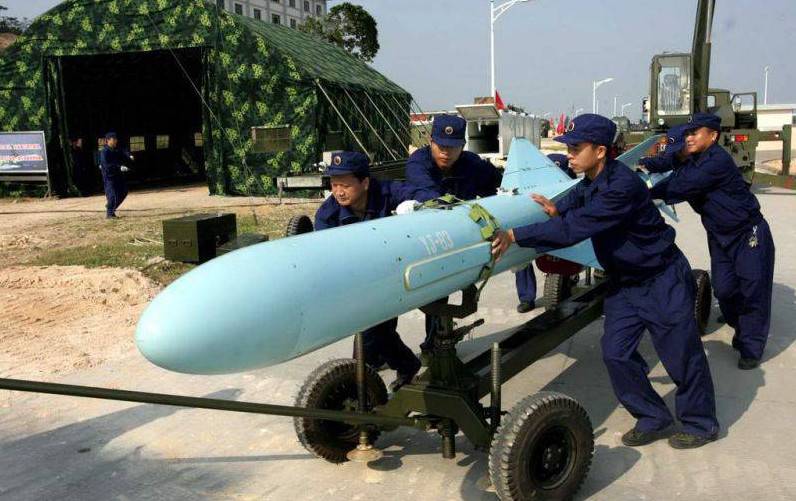
The YJ-83 rocket uses a modern element base, thanks to which it was possible to reduce the volume occupied by electronic components by 25%. This made it possible to increase the mass of the warhead and the capacity of the fuel tank.
According to Chinese sources, the YJ-83 anti-jamming radar seeker with a wide scanning field is used on the YJ-83 anti-ship missiles, which is designed to increase resistance to active and passive interference and increase the likelihood of hitting the target. On the marching section, along with the inertial system, satellite navigation is used, and the flight altitude is controlled by a laser altimeter. These same Chinese sources claim that shortly before hitting the target, the speed of the rocket increases to supersonic, but looking at the shape of the YJ-XNUMX warhead, reasonable doubts arise in this.
Chinese anti-ship missiles of the YJ-8 family are widely used. In the PLA, they are armed with submarines, destroyers, frigates, missile boats, JH-7 bombers, J-10, J-15 and J-16 fighters, as well as Y-8J patrol aircraft.
Export anti-ship missiles were supplied to Algeria, North Korea, Iran, Indonesia, Myanmar, Thailand, Pakistan and Syria. With the help of Chinese specialists, Iran has launched its own production of YJ-82 anti-ship missiles, which received the name "Nur".
RCC family YJ-7
In the late 1980s, the PRC began developing a light anti-ship missile designed to arm fighters, helicopters and boats. For the first time, the YJ-7(C701) solid-propellant rocket was shown at the China's Second International Aviation and Aerospace Show in 1998.
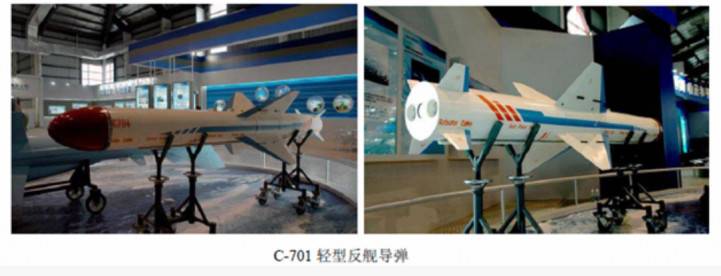
Western experts believe that the appearance of the YJ-7 anti-ship missiles became possible after a detailed acquaintance of Chinese specialists with the American AGM-65A / B Maverick aviation missile. Unlike the American prototype, the Chinese missile, in addition to helicopters and aircraft, can be used from portable launchers mounted on light boats and car chassis.
The first modification of the YJ-7 with IR TGS, with a starting weight of 117 kg and a flight range of 25 km, carried a warhead weighing 29 kg. The flight speed of the rocket is 0,8 M. There is also a modification with a television guidance system.
In 2008, at the Zhuhai Air Show, the YJ-73 (C703) with a millimeter-wave radar seeker was first demonstrated. Following it, the YJ-74 (C-704) and YJ-75 (C-705) missiles appeared with a television and radar seeker in the centimeter range. The launch range of these modifications has increased to 35 km.
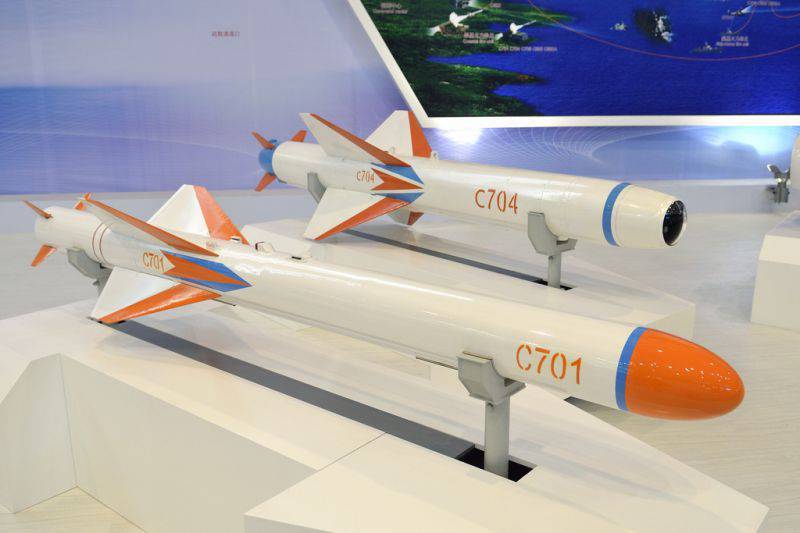
The YJ-75KD anti-ship missile is equipped with a miniature turbojet engine, which made it possible to increase the firing range to 110 km. Correction of the missile's course until the target is captured by the guidance system occurs according to the signals of the satellite positioning system. In addition to fighting ships, the YJ-75KD can be used to destroy ground targets.
Rockets of the YJ-7 family were exported to Iran, which handed them over to the Hezbollah movement. In addition to Iran, YJ-7 series missiles were supplied to Bangladesh, Syria, Egypt and Indonesia.
During the 2006 Lebanon War, a Chinese-made missile attacked the Israeli corvette Hanit. The ship was damaged, but remained afloat, four crew members were killed.
In March 2011, 200 km off the coast of Israel, the cargo ship Victoria was stopped for inspection, sailing under the Liberian flag from the Syrian port of Latakia to Egyptian Alexandria. Israeli special forces found cargo on board weapons and ammunition weighing about 50 tons, hidden under agricultural products.
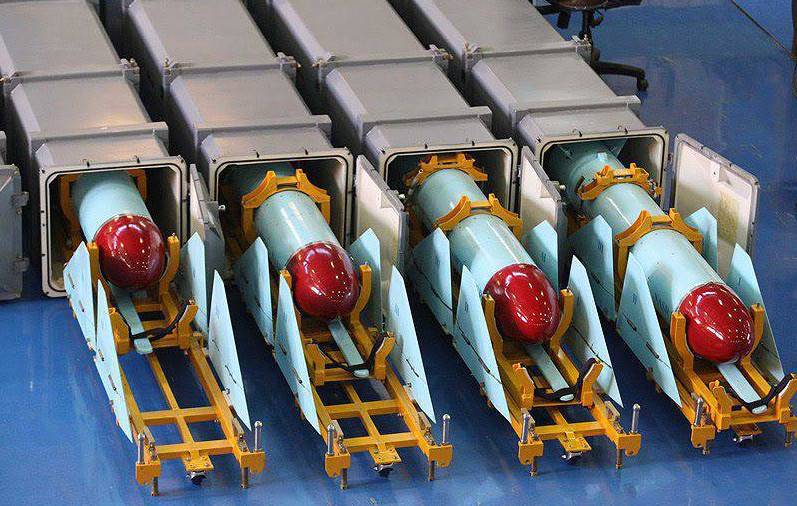
Missiles YJ-74 found on the cargo ship "Victoria"
After convoying the vessel "Victoria" to the Israeli port of Ashdot, a detailed inspection was carried out. Among other smuggled cargo, the Israelis found six YJ-74 anti-ship missiles in transport and launch containers and two guidance stations suitable for installation on ground vehicles.
RCC TL-6
The Chinese copy of the light French anti-ship missile AS.15TT Aerospatiale is the TL-6. This solid-propellant rocket with a launch range of 35 km carries a 30-kg high-explosive armor-piercing warhead. According to the Chinese military, these relatively compact and inexpensive missiles are suitable for destroying ships with a displacement of up to 1 tons and countering amphibious operations in the coastal zone.

RCC TL-6 is equipped with an active radar seeker. A variant of the TL-10 with a television or IR seeker is known. For coastal complexes, the FL-9 rocket was created, which is considered as an inexpensive alternative to the YJ-82. It is known that in addition to the PLA Navy, missiles of this model range are available in Iran.
Modern Chinese anti-ship missiles based on Soviet and Russian missiles
After the collapse of the USSR, China acquired several hundred modern anti-ship missiles 3M-80E ("Mosquito"), 3M54E1 (Club-S) and Kh-31, which became a source of inspiration for Chinese designers.
In the 1970s and 1980s, China tried to create a supersonic anti-ship missile HY-3 with a ramjet engine.
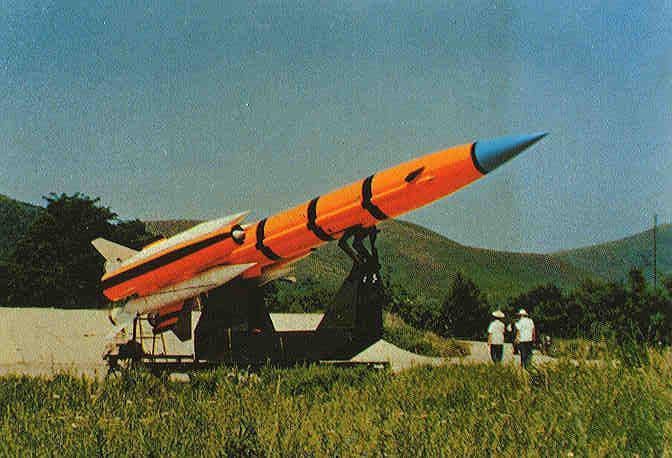
PKR HY-3
The attempt was not very successful: a rocket with a mass of about 3,5 tons had a length of almost 10 m. The launch range did not exceed 160 km, which was clearly not enough for a rocket of this dimension. Due to excessive weight and dimensions, the production of anti-ship missiles HY-3 was limited to an experimental batch.
Chinese specialists, having familiarized themselves with modern Russian missiles that are superior in their characteristics to Chinese developments, have taken steps to copy them. Soon after the delivery of Russian X-31 missiles to the PRC, the Chinese aviation anti-ship missiles YJ-91 saw the light.
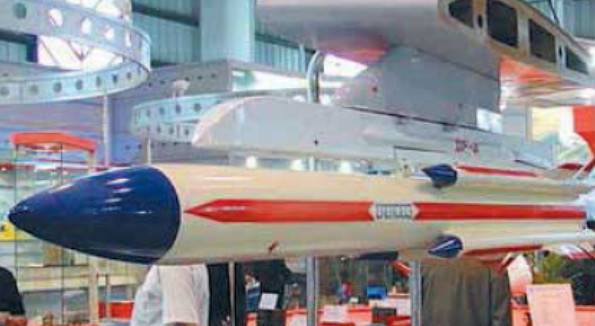
Layout RCC YJ-91
The missile weighing about 600 kg was developed in two versions: anti-ship and anti-radar. These options differ from each other in the guidance system, launch range and weight of the warhead.
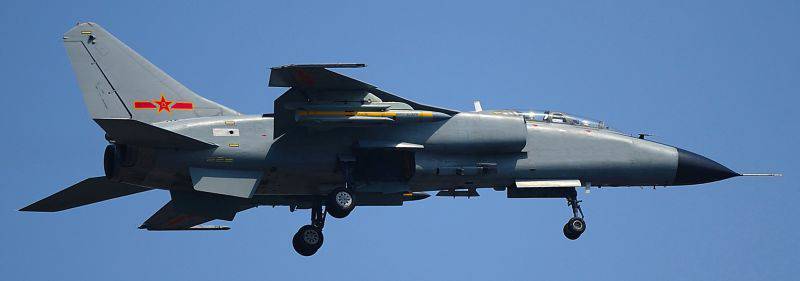
Anti-ship missiles YJ-91 under the wing of a JH-7A bomber
According to Chinese sources, the characteristics of the YJ-91 anti-ship missiles are close to those of the X-31A. YJ-91 missile carriers are JH-7A bombers, J-15 and J-16 fighters.
After the collapse of the USSR, Chinese specialists had the opportunity to get acquainted with many promising Soviet developments. Through Ukraine, full-scale samples of Kh-55 strategic cruise missiles and a set of documentation were received. On the basis of the KR X-55, the YJ-62 anti-ship missile (C602) was created, presented to the general public in 2005.
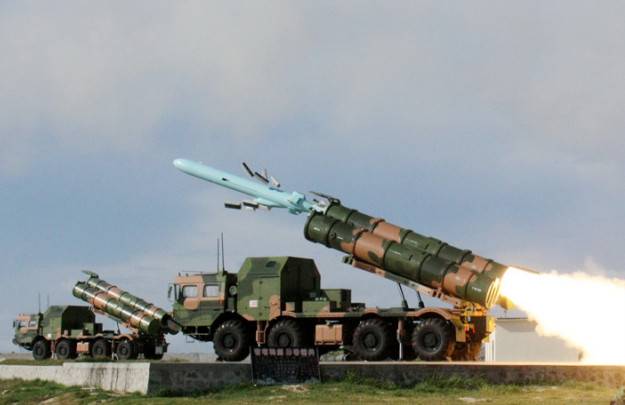
YJ-62 missile launch from a mobile coastal launcher
The launch weight of the YJ-62 rocket is 1 kg. Length with launch booster - 350 m. Hull diameter - 7 m. Wingspan - 0,54 m. Flight speed - 2,9 m. Flight altitude on the cruising section is 0,9-10 m. When attacking a target - 30 m.
In September 2014, the Joint Forces Quarterly published an article stating that the launch range of the upgraded YJ-62A anti-ship missiles had been increased to 400 km. Course correction on the main flight segment is carried out by an inertial autopilot and a satellite navigation system. The YJ-62 RCC is equipped with a data transmission line and is capable of receiving target designation from reconnaissance aircraft in flight, and, if necessary, can select and redistribute targets during salvo use. An active radar seeker is used to guide the missile. In order to increase noise immunity in the conditions of electronic countermeasures, the homing head is capable of quickly changing the radiation frequency according to an arbitrary law. YJ-62 missiles can be equipped with various warheads (including nuclear ones). The most common option is a penetrating warhead weighing 300 kg.
One of the most modern missiles adopted by the PLA is the YJ-18 anti-ship missile. There is little information about this rocket, it has never been exhibited at international aerospace shows and is not offered to foreign buyers. Relatively recently, YJ-18 missiles were demonstrated at the parade.
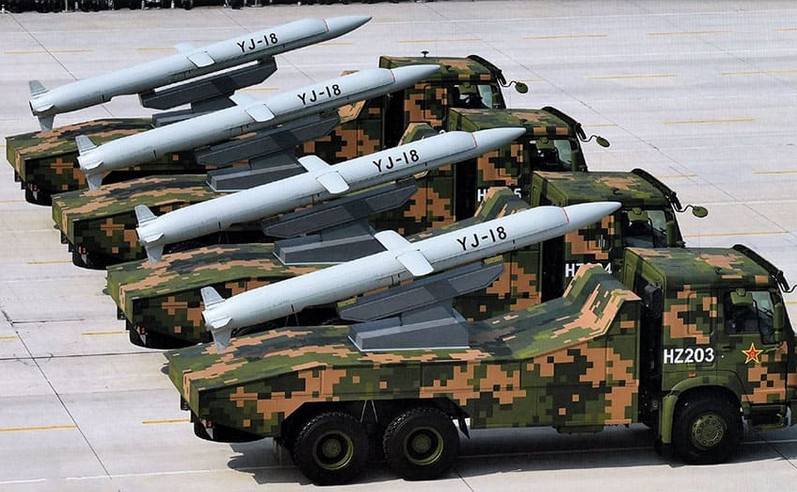
According to American naval analysts, the design and technical solutions of the Russian 18M-3 Klub missile were used to create the YJ-54 anti-ship missile, and it is capable of defeating surface ships of all classes in conditions of intense fire resistance and in difficult jamming conditions. In addition to surface targets, this missile can hit ground-based radio-contrast targets.
After launching and resetting the starting solid-propellant engine, the rocket goes into horizontal flight. To correct the missile's course when firing at the maximum range, signals from satellite navigation systems or radio command control are used. At a distance of 40 km from the target, the engine switches to afterburner mode, and the rocket accelerates to maximum speed.
According to Western data, the cruising speed of the YJ-18 missile does not exceed 300 m / s. At the final stage of the flight, it can increase up to 900 m/s. The firing range in the presence of external target designation can reach 500 km. The mass of the warhead is about 300 kg.
The first version of the anti-ship missiles YJ-18 for coastal missile systems was noticed. The missiles are placed in a twin launcher on a six-axle off-road vehicle chassis.
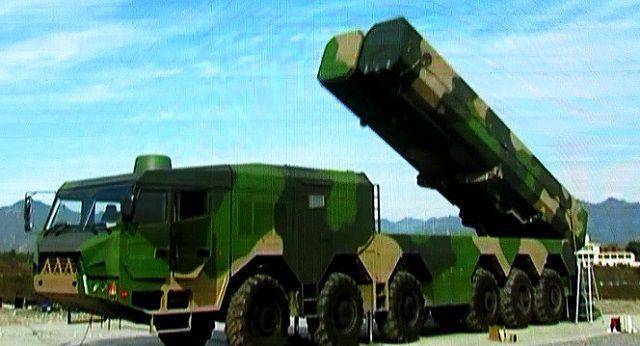
It is assumed that the coastal complex will work in conjunction with a heavy UAV, which should provide reconnaissance and target designation.
RCC YJ-18A is the "main caliber" of the Chinese Aegis destroyers, pr. 52D. It is known that promising warships of Project 55 will also be armed with these missiles. According to Chinese experts, the YJ-18 anti-ship missile is “the best in its class.”
To be continued ...
- Linnik Sergey
- Military-technical cooperation between Western countries and China in the field of aviation and anti-aircraft missiles
Military-technical cooperation between the West and China in the field of combat aviation
Western combat helicopters for China
Chinese MANPADS copied from foreign designs
Chinese missiles based on the Soviet P-15 anti-ship missiles
Information